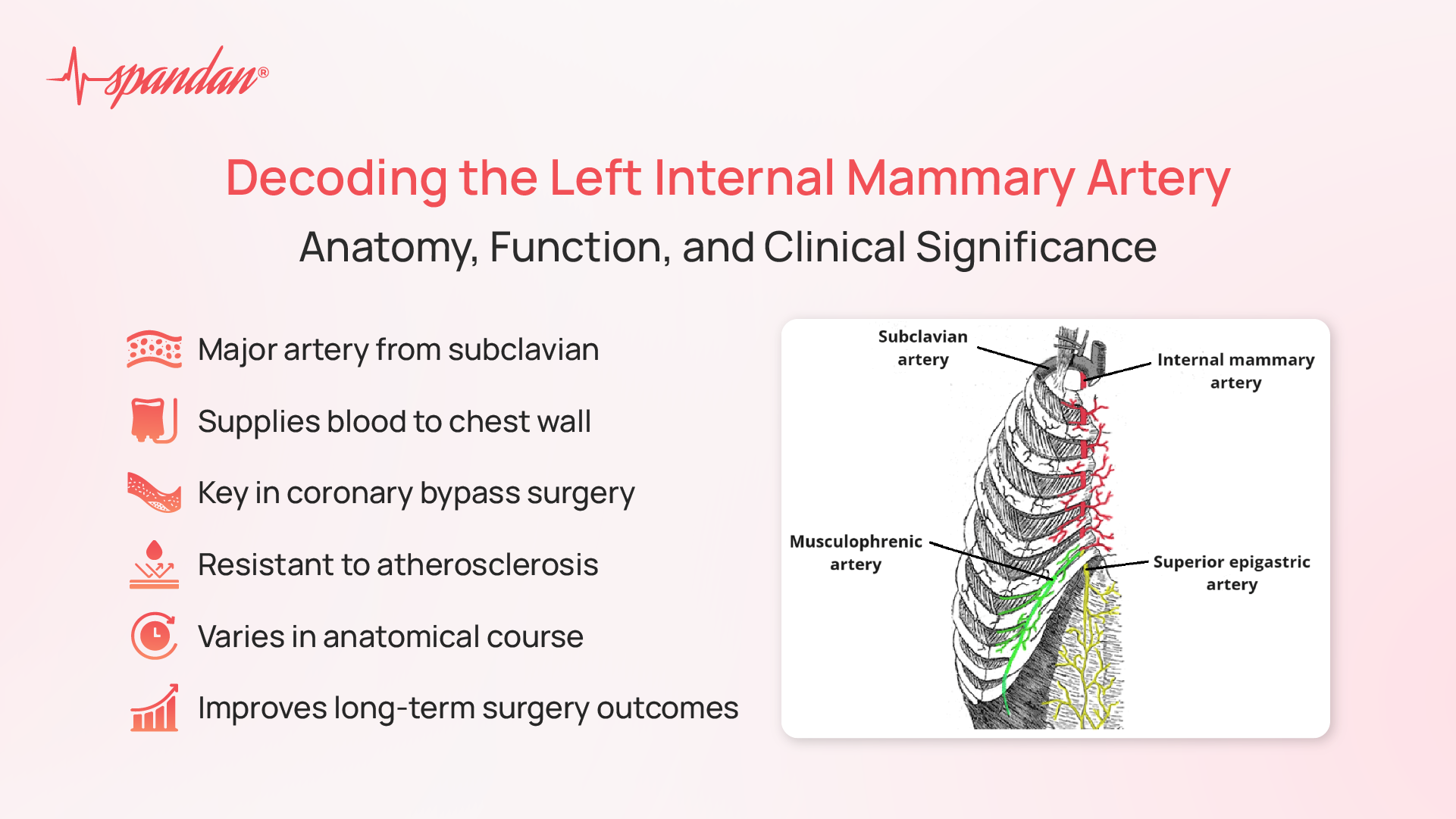
Related Article
Author:- Mr. Ritesh Sharma
The left internal mammary artery (LIMA) is a vital component of the cardiovascular system that often plays a crucial role in both diagnostic and therapeutic aspects of cardiology. This blog delves into the anatomy, function, and clinical significance of the left internal mammary artery, shedding light on why it is so important in the medical field.
Anatomy of the Left Internal Mammary Artery
The left internal mammary artery is a major artery that originates from the subclavian artery, which branches off the aortic arch. It travels downward along the inner aspect of the rib cage, running parallel to the sternum. Its path is primarily along the anterior thoracic wall, making it an important vessel in supplying blood to the breast tissue and the chest wall.
One of the distinctive features of the left internal mammary artery is its involvement in the vascularization of the thorax, including the anterior intercostal spaces. This artery provides crucial blood supply to the skin and muscles of the chest wall, which is significant for maintaining the structural integrity and functionality of the thoracic region.
Function and Clinical Importance
The left internal mammary artery plays several key roles in both normal physiology and clinical practice. Its primary function is to supply oxygenated blood to the tissues of the anterior chest wall. This blood supply is essential for the health and maintenance of these tissues, supporting functions like respiration and movement.
In clinical settings, the left internal mammary artery is notably used in coronary artery bypass grafting (CABG). Due to its favorable characteristics, such as its size, location, and resistance to atherosclerosis, the LIMA is often chosen as a graft to bypass obstructed coronary arteries. The use of the left internal mammary artery as a graft has been shown to improve long-term outcomes in patients undergoing CABG, contributing to the artery’s significance in cardiac surgery.
Diagnostic and Therapeutic Applications
In addition to its role in CABG, the left internal mammary artery is important in diagnostic procedures. For instance, it is commonly assessed during imaging studies like angiography to evaluate its patency and function. Proper evaluation of the LIMA can provide valuable information about the health of the cardiovascular system and help guide treatment decisions.
Moreover, understanding the anatomy and function of the left internal mammary artery is crucial for planning surgical procedures involving the chest. Surgeons must be aware of the LIMA’s location and its relationship with surrounding structures to avoid complications and ensure successful outcomes in both diagnostic and therapeutic interventions.
Variations and Clinical Considerations
The anatomy of the left internal mammary artery can exhibit variations among individuals, which may have implications for surgical planning and clinical practice. Variations in the course or branching patterns of the LIMA can impact its suitability as a graft or affect the outcomes of surgical procedures.
For example, in some cases, the LIMA may have an atypical course or additional branches that need to be considered during surgery. Awareness of these variations is important for minimizing risks and optimizing the effectiveness of surgical interventions.
Long-Term Outcomes and Research
Research into the long-term outcomes associated with the use of the left internal mammary artery in CABG has highlighted its benefits. Studies have shown that patients who receive LIMA grafts often experience better long-term survival rates and lower rates of graft failure compared to those receiving other types of grafts. This makes the LIMA a preferred choice in many cardiac surgeries.
Ongoing research continues to explore the potential benefits of the left internal mammary artery in various clinical scenarios. Advances in surgical techniques and imaging technologies are likely to enhance our understanding of the LIMA and its applications, further solidifying its role in modern medicine.
The left internal mammary artery is a critical component of the cardiovascular system with significant implications for both diagnostic and therapeutic practices. Its unique anatomical features, essential functions, and clinical applications make it a key focus in cardiology and surgical planning. Whether used as a graft in coronary artery bypass surgery or evaluated during diagnostic procedures, the left internal mammary artery plays a vital role in maintaining cardiovascular health and improving patient outcomes.
Understanding the anatomy, function, and clinical significance of the left internal mammary artery is crucial for healthcare professionals involved in cardiac care and surgery. As research and technology continue to advance, the importance of this artery is likely to grow, further underscoring its role in modern medicine.
In summary, the left internal mammary artery is not just a passive conduit for blood flow but a dynamic and vital vessel with profound implications for cardiac health and surgical outcomes. Its contributions to both patient care and medical research highlight its significance in the ongoing quest to improve cardiovascular health and treatment strategies.




